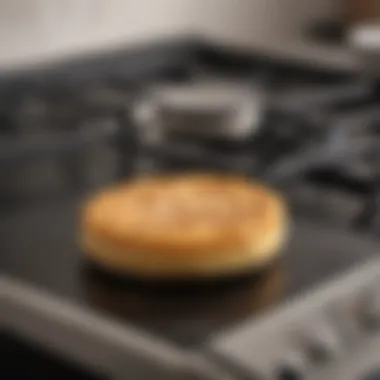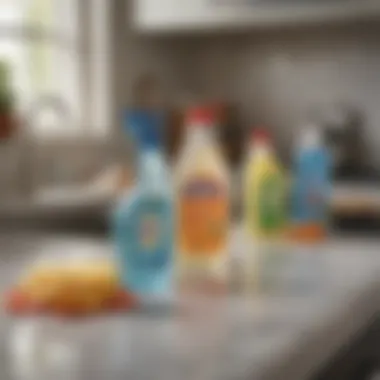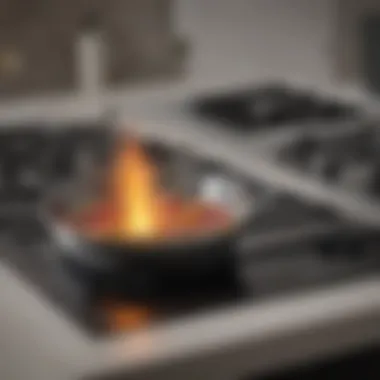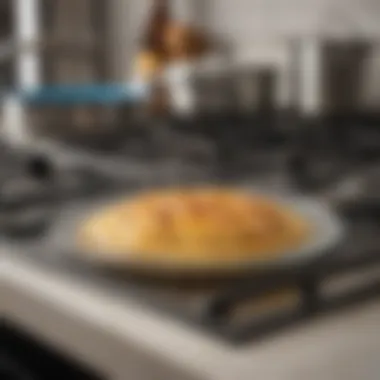A Comprehensive Guide to Cleaning Grease Off Your Stovetop


Intro
Cleaning grease off your stovetop is a task that many dread. However, with the right methods and tools, this process can become manageable. Grease buildup not only makes the kitchen look untidy, but it can also pose a fire risk and affect the hygiene of your cooking space. In this guide, we will cover practical and effective techniques to help you appropriately tackle grease on various stovetop types, including gas, electric, and induction.
greasy surfaces can harbor bacteria, and old grease can produce unpleasant odors. Understanding how to effectively clean your stovetop not only enhances the longevity of the appliance but creates a safer and more inviting cooking environment.
This guide provides an in-depth look at the best cleaning agents, step-by-step methods, and essential preventative tips to keep your stovetops looking brand new. Let's delve into the specific components that will provide you with the knowledge to maintain cleanliness efficiently.
Understanding Stovetops and Grease Accumulation
Understanding the various types of stovetops and the nature of grease buildup is crucial for maintaining a clean kitchen. Stovetops serve as the primary cooking surface in many homes, making them an essential area to keep free from contaminants. Grease accumulation can lead to unsightly stains, unpleasant odors, and even potential hazards, such as fire risks. Recognizing how grease comes to be and the specific features of different stovetops helps to inform cleaning strategies effectively.
Types of Stovetops
Gas Stovetops
Gas stovetops are favored for their precise temperature control. They use an open flame for cooking, leading to fast heating and immediate changes in temperature. This immediacy is a significant advantage for chefs who require quick adjustments.
However, a key characteristic of gas stovetops is that they can attract grease more readily due to spatters from cooking food. The open flame can also cause grease to splatter, making cleaning essential. The unique feature is their design, which often includes grates that can trap grease and debris underneath. While this allows for effective cooking, it necessitates frequent cleaning to avoid buildup that can lead to burnt-on stains and potential odors.
Electric Stovetops
Electric stovetops are known for their sleek and integrated design. They provide an even heat distribution, making them popular in many kitchens. These stovetops often feature smooth surfaces that are relatively easy to clean.
A distinct advantage of electric stovetops is that they allow users to see when they're on or off, enhancing safety. However, one must be cautious of the type of cleaning agents used, as strong abrasives can scratch their surfaces, affecting the aesthetic over time. Regular maintenance is key to ensuring the longevity of electric stovetops, as dried-on food and grease can lead to permanent stains if not addressed quickly.
Induction Stovetops
Induction stovetops are a modern choice that utilizes electromagnetic energy to heat pots and pans directly. This method leads to increased efficiency and minimal heat loss. It’s particularly safe, as the surface remains relatively cool while cooking. However, only compatible cookware can be used with induction stovetops.
A notable feature is that spills do not cook onto the surface due to the lack of direct heat from the stovetop itself. While this might reduce some grease buildup, regular cleaning is still necessary to ensure no residue remains. The unique challenge here is finding appropriate cleaning solutions that won't harm the smooth surface of induction stovetops.
The Nature of Grease Buildup
Sources of Grease
Grease comes from a variety of sources in the kitchen. Cooking oils, butter, and fats from meats can all contribute to the accumulation of grease on stovetops. Each time you cook, microscopic droplets may splatter and settle on the surface, sometimes even hitting the backsplash or surrounding countertops. As these substances cool and harden, they become more challenging to remove. A thorough understanding of these sources can help in choosing effective cleaning methods.
Impact of Heat on Grease
The relationship between heat and grease is significant in the kitchen. When cooking, heat can cause oils to break down and release volatile compounds. As the temperature rises, grease can become more viscous and sticky, adhering firmly to stovetop surfaces. This can result in stubborn stains, requiring a more intensive cleaning approach.
Knowing how heat affects grease can inform users about when to clean their stovetops effectively. Immediate cleaning after cooking reduces the chance of grease hardening, thus facilitating easier cleanup down the line. Regular maintenance and understanding the dynamics involved are crucial for keeping stovetops hygienic and functional.
Essential Cleaning Supplies
Cleaning grease from your stovetop is a task that requires the right tools and materials. Without the proper supplies, even the toughest stains can remain stubbornly in place. Understanding the essential cleaning supplies helps to ensure a more efficient and effective cleaning process. This section focuses on two main categories of cleaning agents: kitchen cleaners and cleaning tools. Each has its own significance in achieving a grease-free surface.
Kitchen Cleaners
Degreasers
Degreasers are specialized cleaning agents designed to break down and remove grease effectively. These products are particularly beneficial because they contain strong ingredients that target oily substances. One key characteristic of degreasers is their ability to penetrate grease quickly, making them a popular choice among individuals seeking immediate results.
Using a degreaser offers distinct advantages. For instance, they can often cut through layers of grease that other cleaning agents cannot tackle. However, caution is necessary as some degreasers may contain harsh chemicals that can harm certain surfaces or emit strong fumes. Thus, it is important to always check manufacturer recommendations before using these products on your stovetop.
Natural Cleaners


Natural cleaners have gained popularity due to their environmentally friendly and non-toxic nature. These options are made from common household ingredients such as vinegar, baking soda, or lemon juice. The primary advantage of using natural cleaners is their safety for both the user and the environment. They typically do not pose risks of toxic exposure, making them an attractive choice for households with children or pets.
While natural cleaners are safe, their effectiveness may vary based on the level of grease present. Some tough stains may require repeated applications or a bit of additional scrubbing. Their unique feature is that they are often very affordable and easy to make at home, but it can take longer to achieve the desired results compared to traditional commercial degreasers.
Cleaning Tools
Sponges and Scrubbers
Sponges and scrubbers are vital tools in the cleaning process as they help physically remove grease from the stovetop surface. A significant characteristic of these tools is their varied textures. Soft sponges can soak up cleaner and grime while scrubbers often have a rough surface, perfect for tackling stuck-on residue. Utilizing both allows for an effective two-step cleaning process.
Their benefits lie in their versatility. Depending on the surface material of your stovetop, you can choose a sponge or scrubber that suits it best. However, care must be taken when cleaning delicate surfaces, as certain scrubbers can scratch glass or ceramic finishes.
Microfiber Cloths
Microfiber cloths are another essential item in effective stovetop cleaning. Their unique fibers absorb liquid and lift dirt more efficiently than regular cloths. This characteristic makes them particularly effective in completing the cleaning process, especially after applying a cleaner.
Microfiber cloths are favored for their ability to leave surfaces streak-free. They are also reusable, ensuring that you are not frequently stocking up on disposable options. However, one minor drawback is the need for proper care, as they must be washed correctly to maintain their cleaning effectiveness.
Proper cleaning supplies make a significant difference in the outcome of your stovetop cleaning efforts. Selecting the right products helps create a clean and hygienic cooking environment.
Step-by-Step Cleaning Techniques
Cleaning grease off your stovetop is not just about aesthetics; it also ensures proper functionality and safety while cooking. This section outlines systematic methods to effectively remove grease buildup, allowing for a cleaner, healthier cooking environment. Applying these techniques methodically maximizes the effectiveness of the cleaning process. Each step is crucial, from preparation to final rinse, ensuring that no debris is left behind.
Preparation
Gathering Materials
A proper cleaning session begins with gathering the right materials. Having all necessary items at hand streamlines the process and ensures efficiency. Essential tools include a degreaser, sponges, microfiber cloths, and hot water. The key characteristic of gathering materials is preparedness, making cleaning less stressful. Choosing easily accessible and effective products like vinegar, baking soda, or commercial degreasers is a beneficial choice in this context. Their unique features are versatility and efficiency, helping to tackle various types of grease effectively. It is important to note that cheap or ineffective products can waste time and effort, so stearing clear of those is wise.
Ensuring Safety
Ensuring safety is a critical aspect of any cleaning task. This involves wearing gloves to protect your skin from harsh chemicals and ensuring the stovetop is cool before beginning. The key characteristic of this preparation step is caution, which prevents accidents and injuries. It's essential to have a safe environment while cleaning, making it beneficial to prioritize safety measures. A unique feature of ensuring safety is to keep children and pets away from the area during the cleaning process. This precaution minimizes risks associated with cleaning solutions and any residual loose debris.
Initial Wipe Down
Removing Loose Food and Debris
An initial wipe down is vital for effective cleaning. Removing loose food and debris is the first step to prepare the stovetop for a deeper clean. This process helps to identify areas of stubborn grease. The key characteristic of this step lies in simplicity, which makes it a basic yet beneficial choice. Utilizing a dry cloth or paper towel did its job and is quick, allowing the cleaner to focus on tougher spots later. However, an often-overlooked aspect is that neglecting this can lead to larger cleaning tasks if food particles mix with cleaning agents, causing further issues.
Using Warm Water
Using warm water is a crucial part of the initial wipe down. Warm water helps to loosen grease and allows for easier removal, contributing significantly to the cleanup process. The key characteristic of warm water is its ability to dissolve oil and fat more effectively than cold water. This method is a popular choice for its ease of use and efficiency. Warm water also enhances the effectiveness of cleaning agents, leading to a more thorough clean. A disadvantage could be potential burns if the water is too hot; thus, caution is recommended.
Applying Cleaning Solution
Spraying Method
The spraying method is effective for applying cleaning solutions to the stovetop. This technique distributes the cleaner evenly and covers all surfaces without oversaturation. The key characteristic of this method is precision, which allows for targeted application. This approach is beneficial, as it reduces waste and ensures no spots are missed. A unique feature of the spraying method is the ease of control, allowing you to apply pressure as needed without causing a mess.
Letting it Sit
Letting the cleaning solution sit is an essential step. This waiting period allows the cleaner to penetrate and dissolve the grease effectively. The key characteristic of this step is patience, enhancing the overall effectiveness of the cleaning process. This method is beneficial since it makes scrubbing easier afterward. A unique aspect of this approach is the ability to tackle multiple cleaning areas, as allowing one section to soak can give attention to others in the meantime. However, excessive waiting may lead to residue build-up, emphasizing the importance of timely follow-up scrubbing.
Scrubbing Techniques
Using Circular Motions


Using circular motions while scrubbing is an effective technique. This method helps dislodge the grease without damaging the surface. The key characteristic of this approach is its thoroughness. Circular motions allow for even pressure distribution, which is beneficial for covering larger areas efficiently. A unique feature is that it ensures all angles are reached, making it harder for dirt and grease to remain. However, diligent care is needed to avoid creating scratches, especially on sensitive surfaces like glass or stainless steel.
Focusing on Stubborn Areas
Focusing on stubborn areas is crucial for a complete clean. Certain spots require more attention due to grease accumulation. The key characteristic of this strategy is targeting, which helps address particularly difficult grease patches. This approach is beneficial as it ensures you are not neglecting any crucial parts of the stovetop. One unique feature of this method is the potential to use a different tool or a more robust cleaner specifically on problematic areas. Not paying sufficient attention to these spots can lead to persistent stains, complicating future cleaning efforts.
Final Rinse and Dry
Removing Residue
Removing residue after scrubbing is the next vital step. This involves rinsing all cleaning solutions away with clean water. The key characteristic of this action is thoroughness, ensuring that no chemicals remain on the stovetop surface. This step is beneficial as it prevents any lingering residues that could affect food safety. A unique feature of residue removal is that it enhances surface shine, providing a polished look post-cleanup. Overlooking this step can lead to unpleasant flavors during future cooking sessions.
Drying with a Cloth
Drying with a cloth concludes the cleaning process. This step ensures that the stovetop is ready for immediate use. The key characteristic lies in its ability to prevent water spots and streaks. Using a soft microfiber cloth is a popular choice for its absorbent nature and effectiveness in securing a streak-free finish. This method's unique feature is that it not only dries the surface but also leaves it shining. A potential downside to this step is that using the wrong type of cloth may scratch or leave lint, so choosing wisely is necessary.
Special Considerations for Different Stovetop Types
Understanding how to clean different types of stovetops is vital for maintaining them effectively. Each stovetop, whether gas, electric, or induction, comes with its own set of challenges regarding grease removal. Knowing these specificities ensures that the cleaning process does not inadvertently damage the appliance or reduce its efficiency. Tailoring your cleaning methods to the stovetop type can improve cleanliness while safeguarding its longevity and functionality.
Cleaning a Gas Stovetop
Removing Grates and Burners
Removing the grates and burners is an essential step when cleaning a gas stovetop. It allows for deep access to dirt and grease that accumulates beneath these components, which can be difficult to reach otherwise. The benefit of this approach is that it enables the use of powerful cleaning solutions on exposed surfaces.
When grates and burners are removed, the user can effectively scrub both the stovetop surface and the underside of the grates. This method often leads to better cleaning results. However, a drawback is the need for careful handling of the burners to avoid disrupting their attachments or fittings during the reinstallation process.
Deep Cleaning Tips
Deep cleaning a gas stovetop enriches the overall cleaning goal. It involves using specialized products designed to dissolve heavy grease and food residues. Employing a combination of baking soda and vinegar is a popular tip among users. This method is effective in tackling stubborn stains without resorting to harsh chemicals, preserving the stovetop's finish.
The primary advantage of deep cleaning is the thoroughness it provides. However, it may require more time and effort. Finding the right balance between regular cleaning and deep cleaning is essential for optimal maintenance while minimizing effort.
Cleaning an Electric Stovetop
Appropriate Cleaning Agents
Choosing the right cleaning agents for an electric stovetop is crucial. Some cleaners are too abrasive and can scratch or damage the appliance’s surface. Products specially formulated for electric stovetops often come with promises of scratch resistance, making them a desirable choice for readers.
Using appropriate cleaning agents ultimately helps in maintaining the appearance and function of the stovetop. It is also essential to follow the manufacturer’s guidelines to avoid voiding warranties. A well-selected cleaner contributes to the effectiveness of the cleaning process without risking the appliance’s integrity.
Preventing Scratches
Preventing scratches on electric stovetops is critical for long-term usability. By using soft cloths or sponges and refraining from using metal scrubbers, users can significantly avoid surface damage. This practice aligns well with maintaining aesthetics and ensuring smooth cooking surfaces.
The key characteristic of preventive measures is their simplicity. With just a few adjustments to cleaning habits, one can extend the stovetop's lifespan. However, it requires consistent awareness, and the effort may seem minor until the surface damage becomes apparent.
Cleaning an Induction Stovetop
Considerations for Smooth Surfaces
Smooth surfaces on induction stovetops demand a cautious approach to cleaning. The lack of texture means that particles can stick more easily, leading to potential buildup that can hinder functionality. Users must be diligent in cleaning after each use to prevent this.
Unique to induction cooking is the need for delicate yet effective techniques. Avoiding cleaners that contain harsh chemicals helps maintain the induction stovetop's appearance. The need for a gentle touch while cleaning is both an advantage and a disadvantage. Users may find that while it prevents damage, it also requires more frequent attention.
Using Safe Cleaners


Utilizing safe cleaners designed for induction stovetops is fundamental. The right products preserve the smooth surface while providing effective grease removal. Often these cleaners are non-abrasive and eco-friendly, striking a balance between performance and safety.
The advantage of safe cleaners is clarity; using them minimizes risks associated with toxic chemicals. However, availability may vary depending on location, and consistency might affect ongoing grease issues. Keeping a stock of safe cleaners can alleviate this concern and ensure effective cleaning routines.
Preventive Measures for Maintaining Cleanliness
Preventive measures play an essential role in maintaining the cleanliness and functionality of stovetops. This section focuses on how proactive actions can reduce grease buildup and enhance the overall cooking experience. By integrating these practices into daily life, anyone can significantly decrease the time and effort required for intensive cleanings. Consistency is key in achieving a clean and hygienic cooking space.
Daily Maintenance Practices
Wiping Down After Use
Wiping down the stovetop after each use is crucial in keeping surfaces clean. This simple gesture prevents food particles and grease from settling and hardening. The key characteristic of this practice is its immediacy; it is done shortly after cooking. It eliminates any moisture or food that could attract more grime. This approach is beneficial because it vastly reduces the time needed for deep cleanup later.
Some advantages include:
- Efficient Cleaning: A quick wipe can often be sufficient to maintain general cleanliness.
- Reduced Stains: Regularly wiping down surfaces minimizes the likelihood of stubborn stains forming.
However, it requires a certain level of diligence, as forgetting this step could lead to tougher cleaning later on.
Using Splatter Guards
Utilizing splatter guards is another preventive measure that can greatly enhance cleanliness during the cooking process. These are typically placed over pots and pans to catch oil and food particles that may leap from cookware. The key characteristic of splatter guards is their ability to protect the stovetop from direct exposure to grease.
They are a popular choice because they:
- Prevent Mess: A splatter guard can drastically reduce the amount of grease that makes contact with the stovetop.
- Ease of Cleaning: Many splatter guards are dishwasher safe, making them easy to clean after use.
On the downside, some users may find that they can be cumbersome to use, and certain designs may not fit all cookware types.
Periodic Deep Cleaning
Establishing a Cleaning Schedule
Establishing a cleaning schedule is beneficial for managing stovetop cleanliness over time. By setting specific days for deeper cleaning sessions, individuals can ensure that grease and grime do not accumulate excessively. The key characteristic of a cleaning schedule is its regularity, making it easier to track maintenance tasks.
This approach is widely recognized because:
- Consistency is Key: Regularly scheduled cleanings can lead to a noticeable difference in cleanliness and hygiene.
- Time Management: By planning cleaning days, one can allocate the right amount of time for deep cleaning without feeling rushed.
Despite its benefits, some may struggle with sticking to the schedule due to busy lifestyles. This could lead to inconsistent cleaning.
Identifying Problem Areas
Identifying problem areas on the stovetop is another critical aspect of maintaining cleanliness. This involves monitoring sections of the stovetop that attract more grease or food residue. The key characteristic of this process lies in its focus, as it makes deep cleaning more effective.
It is advantageous because:
- Targeted Cleaning: Knowing which areas require more attention helps prioritize cleaning efforts.
- Resource Efficiency: This approach saves time and cleaning supplies by focusing efforts where they are needed most.
However, this requires a degree of awareness and attentiveness while cooking. If one becomes complacent, problem areas may continue to accumulate grease.
The End
Cleaning grease off your stovetop is not just a chore; it is a crucial part of kitchen maintenance that has direct implications for hygiene and safety. Throughout the article, we explored various techniques, tools, and cleaners relevant to different stovetops including gas, electric, and induction. Each method outlined is designed to effectively remove grease buildup, ensuring your cooking surface remains both functional and aesthetic.
Regular cleaning helps prevent the accumulation of stubborn grease that can become increasingly difficult to manage over time. This not only enhances the longevity of your appliance but also maintains a healthy cooking environment.
Key benefits of adopting a consistent cleaning routine include:
- Improved appearance of the stovetop, creating a more pleasant cooking space.
- Decreased risk of fire hazards caused by grease buildup.
- Enhanced efficiency in cooking, as a clean surface allows for better heat distribution.
Additionally, we discussed preventive measures like daily maintenance and periodic deep cleaning. These practices are essential. They not only save time in the long run but also serve to identify problem areas before they escalate into larger issues.







